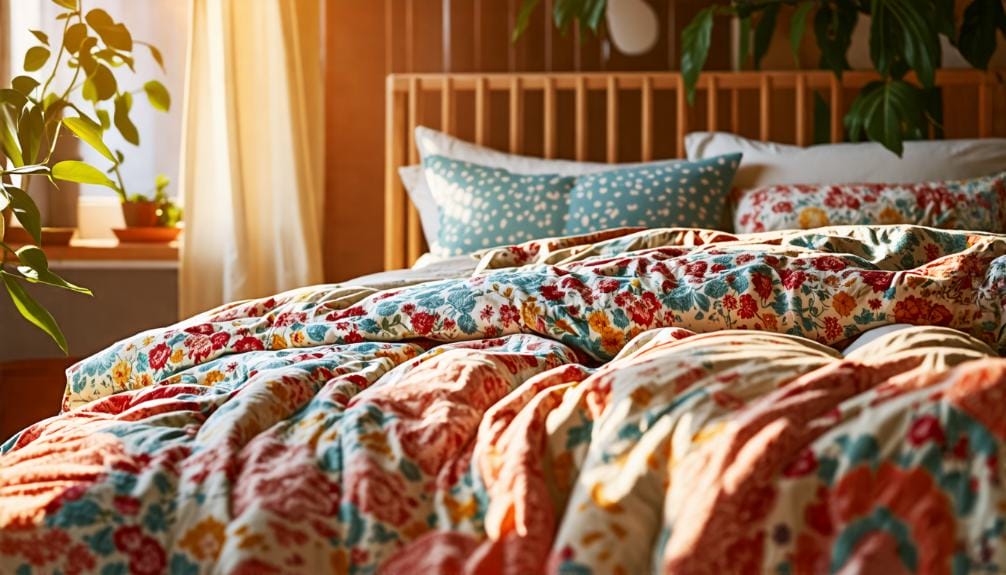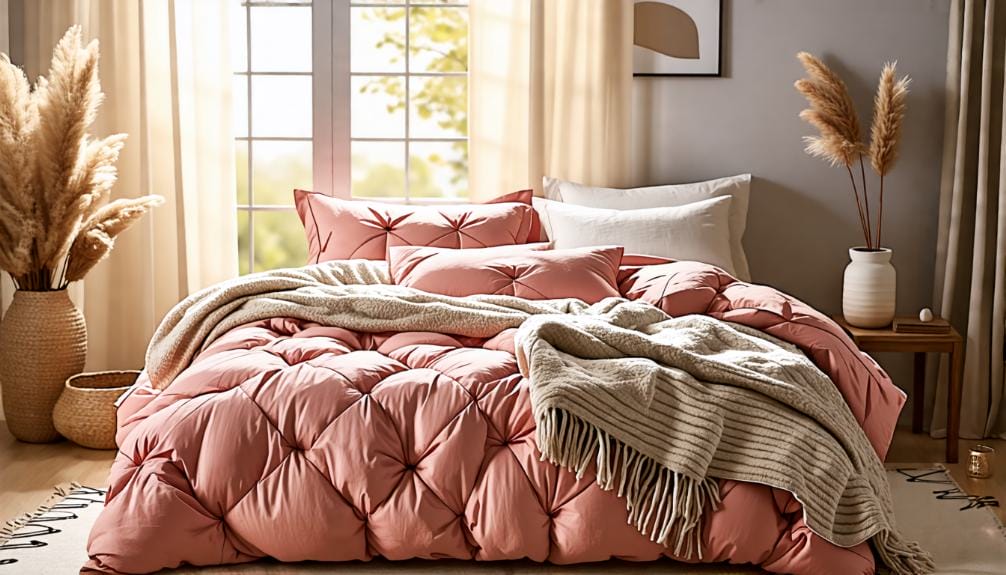Can You Put a Comforter in a Duvet Cover? The Simple Truth
You might be wondering if you can put a comforter in a duvet cover, and the straightforward answer is yes. This combination not only improves your bedding’s comfort but also offers a stylish way to protect your comforter from daily wear and tear. However, the process of inserting the comforter can be a bit tricky if you’re not familiar with it. So, what’s the best method to achieve that perfect fit without ending up with a lumpy mess? Let’s explore the details that could make all the difference for your bedding setup.
Can You Use a Comforter in a Duvet Cover?

Yes, you can use a comforter in a duvet cover. This practice offers several advantages.
It protects your comforter from dirt and spills, and it allows you to change the look of your bedroom easily without needing to buy new bedding.
This approach gives you the opportunity to personalize your space while keeping it comfortable and clean.
Practical Benefits
Using a duvet cover with your comforter serves multiple practical purposes.
First, it acts as a protective layer, shielding the comforter from dirt, spills, and everyday wear. This protection helps preserve the comforter’s quality, allowing it to last longer.
Changing the duvet cover offers a simple and cost-effective way to refresh your bedroom decor. You can easily swap out covers to align with seasonal themes or simply to change the overall look of your space. This allows for a quick transformation, whether you prefer soothing colors or bold patterns that make a statement.
Maintenance is another significant advantage. Most duvet covers are machine washable, which makes it easy to keep your bedding clean. Regular washing of the cover helps prevent stains from reaching the comforter, contributing to its longevity.
Aesthetic Flexibility
A duvet cover serves a practical purpose by safeguarding your comforter while also providing an opportunity to personalize your bedroom decor. By opting for a duvet cover, you can easily change the look and feel of your space, making it simple to align with your style preferences or seasonal themes. This approach allows for an effective transformation of your bedroom without the expense of new comforters or bed linens.
Switching out a duvet cover makes it quick and straightforward to refresh the appearance of your bed. You can transition from soft, muted tones to vibrant, eye-catching designs in no time. This versatility not only enables you to express your personality but also keeps your bedroom looking new and inviting.
The choice of fabric for your duvet cover is equally important, as different materials can significantly impact both the aesthetic and comfort of your sleeping environment. Options range from breathable cotton to sumptuous silk, each providing a distinct feel and appearance. Choosing the right duvet cover not only protects your comforter but also contributes to a personalized space that reflects your individuality.
What Types of Comforters Fit?
To find a comforter that fits well in your duvet cover, consider thickness and weight.
A thick down comforter may be difficult to fit into a tight duvet cover, while a lightweight synthetic comforter is likely to fit more easily.
The materials of both the comforter and duvet cover also affect comfort and breathability, so choose them carefully to ensure compatibility.
Thickness and Weight
To find the right comforter for your duvet cover, focus on thickness and weight.
Start by measuring the dimensions of your comforter—length and width—and then check those against the duvet cover’s specifications. Most duvet covers are available in standard sizes like twin, full, queen, and king, so accurate measurements are crucial.
Next, evaluate your comforter’s thickness. Lightweight comforters easily slip into duvet covers, while thicker, fluffier options may require more effort and could fit snugly. If the comforter is too bulky, it may not slide in smoothly, leading to an unattractive appearance.
Weight is also significant. Heavier comforters can make the duvet cover feel cumbersome, particularly if you prefer a light and airy setup. Look for a duvet cover that can accommodate the weight of your comforter to ensure a comfortable sleeping experience.
Material Considerations
The material of your comforter is crucial for ensuring it fits properly inside a duvet cover, as well as for influencing your sleep quality.
For example, down comforters are known for their softness and fluffiness, which can make them bulkier and harder to fit into certain duvet covers. In contrast, synthetic comforters are typically lighter and thinner, making them easier to fit.
It’s also important to consider the duvet cover’s material. Cotton is a popular choice due to its breathability and ease of care. Linen, on the other hand, offers a textured and laid-back aesthetic.
For those seeking a touch of luxury, silk duvet covers can enhance your bedroom’s decor and provide a distinct sleeping experience.
Choosing the right combination of comforter and duvet cover materials can significantly impact both the look of your bedding and your comfort while sleeping.
How Do You Insert a Comforter?

Inserting a comforter into a duvet cover is simple if you follow these clear steps.
First, lay the duvet cover inside out on a flat surface.
Next, place the comforter on top of the cover. Align the corners of the comforter with the corners of the duvet cover.
To secure the comforter, use the ties or buttons inside the duvet cover if available.
Finally, turn the duvet cover right side out, pulling the comforter inside as you do so. Smooth out any lumps or wrinkles to achieve a neat look.
With these straightforward steps, you’ll have your comforter properly inserted in no time.
Step-by-Step Process
Inserting your comforter into a duvet cover is a straightforward process that can enhance the look and feel of your bedding.
First, lay the duvet cover inside out on a flat surface with the opening positioned at the foot of the bed. This orientation is important for easy access and smooth insertion.
Next, take your comforter and align it with the duvet cover. If you’ve measured your comforter and duvet cover beforehand, this alignment should be simple.
Grab the top corners of both the duvet cover and the comforter together. While holding onto the corners, flip the duvet cover right-side out. This technique ensures the comforter stays in place.
Check to make sure the comforter is snugly enclosed within the duvet cover. For a more breathable experience, consider using fabrics like cotton or bamboo, which can improve comfort during sleep.
Once everything is aligned, secure the opening by using buttons, ties, or zippers, depending on your duvet cover design.
After securing the cover, adjust the comforter inside to your preference, allowing you to express your personal style through different colors and patterns.
Tips for a Smooth Fit
Before inserting your comforter into the duvet cover, it’s essential to prepare the cover correctly.
Lay the duvet cover flat on your bed with the inside facing out. Align the corners of your comforter with those of the duvet cover. If your comforter appears bulky, verify the dimensions of both items to confirm they match for a proper fit.
For an efficient insertion, use the ‘burrito method.’
Start by tightly rolling your comforter and placing it at the bottom of the duvet cover. Then, fold the duvet over the comforter and roll them together toward the top. Once you reach the top, unroll the duvet cover while keeping hold of the comforter, ensuring everything settles neatly inside.
This technique simplifies the process and helps avoid any bunching or misalignment.
What Fabric Works Best for Duvet Covers?
For duvet covers, cotton is a top choice due to its breathability and softness.
Other materials like silk and bamboo can also be beneficial, providing different textures and better temperature control.
Think about what feels comfortable for you to create a cozy sleeping environment.
Cotton vs. Other Materials
Selecting the right fabric for your duvet cover is essential for achieving the desired comfort and aesthetic in your bedroom.
Cotton is a favored option due to its breathability, which helps regulate temperature while sleeping, making it suitable for use throughout the year. Its soft texture contributes to a cozy sleeping environment, and cotton’s ease of care means less hassle for you.
Linen is another fabric worth considering. It has a distinct, textured feel and is naturally moisture-wicking, making it ideal for individuals who tend to sleep hot.
Silk, on the other hand, offers a luxurious experience and retains warmth during colder months, although it requires more careful handling during washing.
For those who prioritize durability and low maintenance, synthetic fabrics like polyester can be a practical choice. They’re often stain-resistant, but they may lack the breathability found in cotton or linen.
Your decision should reflect your preferences regarding comfort, care, and the overall look you wish to achieve in your bedroom. Keep these factors in mind to find the perfect duvet cover fabric that suits your lifestyle.
Impact on Sleep Quality
The fabric of your duvet cover significantly impacts your sleep quality by influencing comfort and temperature regulation. A breathable duvet cover works in tandem with your comforter to enhance airflow, helping to keep your body at an optimal sleep temperature.
Cotton is a popular choice due to its softness and moisture-wicking properties, which keep you cool on warm nights. For those who prefer a more luxurious option, silk offers elegance and breathability but may lack the warmth of thicker materials. Bamboo is another excellent alternative; it provides breathability and effective temperature control, making it suitable for a restful night’s sleep.
Selecting the right fabric for your duvet cover isn’t only about comfort but also about showcasing your personal style. Bright colors and distinctive patterns can transform your bedroom into a cozy retreat that reflects your individual taste.
Why Choose a Duvet Cover?

A duvet cover allows you to showcase your personal style while also being eco-friendly.
Instead of buying new comforter sets regularly, you can simply change the cover to refresh your bedroom’s look.
This approach saves you money and supports a more sustainable lifestyle.
Personal Expression
A duvet cover is an essential addition to your bedroom, offering a simple way to express your personal style while adding comfort. By using a duvet cover, you can easily change the look of your bedding without needing to buy an entirely new comforter.
This flexibility allows you to swap covers based on your mood or the changing seasons, whether you prefer a soothing solid color or a lively pattern that brings energy to the room.
The right duvet cover plays a significant role in the overall appearance of your bedroom. It can turn a plain comforter into a focal point that unifies the decor.
Consider how a soft, textured fabric can create an inviting and luxurious atmosphere, making your bed a welcoming space. This practical element not only serves a functional purpose but also elevates the aesthetic appeal of your bedroom.
Environmental Considerations
Opting for a duvet cover not only elevates your bedroom’s appearance but also supports a sustainable approach to bedding. Using a duvet cover helps preserve the lifespan of your comforter and reduces waste. Here’s why this choice matters:
- Less Waste: Instead of frequently purchasing new comforters, you can easily refresh your bedding by swapping out the duvet cover, which significantly cuts down on textile waste.
- Lower Laundry Impact: Duvet covers can be laundered more often than comforters, leading to decreased water usage and energy consumption, making your laundry routine more eco-friendly.
- Increased Longevity: By shielding your comforter from dirt and potential damage, you prolong its life. This means fewer resources are needed for production and disposal in the long run.
- Sustainable Fabrics: Many duvet covers are crafted from eco-friendly materials such as organic cotton or bamboo, allowing you to make choices that are better for the environment.
Choosing a duvet cover is a practical step toward a sustainable lifestyle, offering both style and environmental benefits. This decision not only reflects your personal taste but also promotes a healthier planet.
The next time you refresh your bedding, remember the positive impact a duvet cover can have.
Frequently Asked Questions
Can I Wash a Duvet Cover With a Comforter Inside?
No, you shouldn’t wash a duvet cover with a comforter inside. It can cause uneven cleaning and damage. Instead, remove the comforter first, then wash the duvet cover separately for the best results.
How Often Should I Change My Duvet Cover?
You should change your duvet cover every one to two weeks, depending on your lifestyle. Regularly washing it helps maintain cleanliness and freshness, ensuring a cozy, inviting sleep environment. Don’t forget to enjoy the process!
Are Duvet Covers Hypoallergenic?
Yes, duvet covers can be hypoallergenic, especially if made from materials like cotton or bamboo. They help reduce allergens by protecting your comforter and are easier to wash, making your sleeping environment healthier.
Can I Use a Duvet Cover Without a Comforter?
Yes, you can use a duvet cover without a comforter. Just insert a lightweight blanket or even a soft quilt for a cozy feel. It’s a great way to change your bedding look while staying comfortable.
What Sizes Do Duvet Covers Come In?
Duvet covers come in various sizes, including twin, full, queen, and king. When choosing, make certain your duvet cover matches your comforter’s size for a snug fit. It’ll improve both comfort and aesthetic in your bedroom.
In Conclusion
To sum up, yes, you can definitely use a comforter in a duvet cover, and it’s a smart choice for both style and practicality.
Not only do duvet covers protect your comforter and extend its life, but they also let you change up your bedroom decor easily.
By choosing the right fabric and using simple insertion techniques, you can enjoy a cozy and stylish bed while promoting sustainability.
So go ahead and elevate your bedding game!
